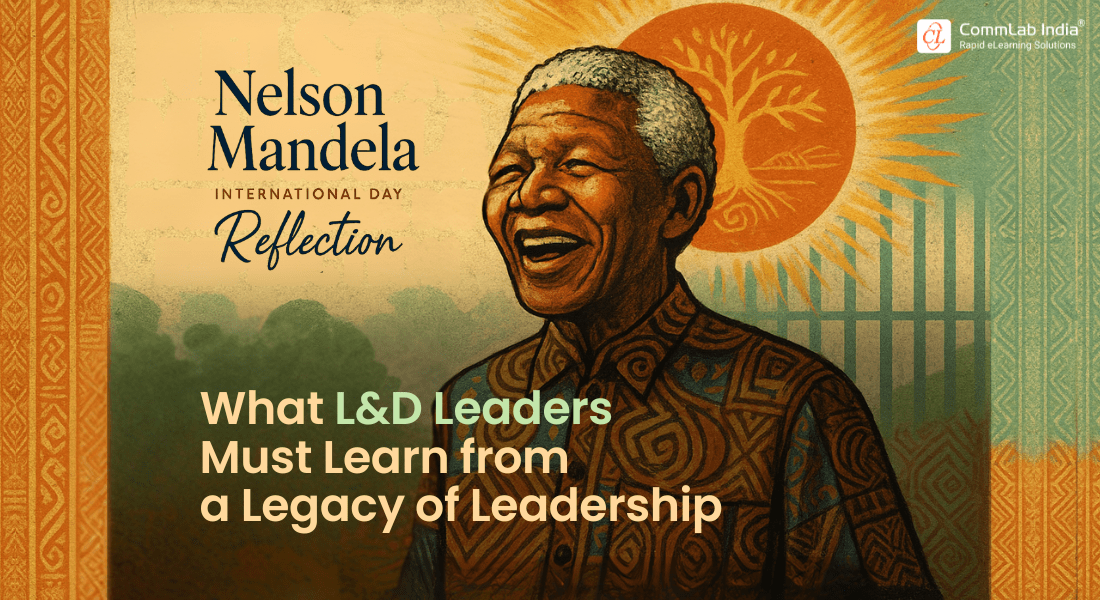
A Mandela Day Message for L&D Teams
Some leaders demand attention. Others command respect. But then there are a rare few like Nelson Mandela who inspire transformation simply by embodying what it means to lead with courage, conviction, and compassion.
Born in rural South Africa in 1918, Mandela rose from humble beginnings to become a lawyer, activist, political prisoner, and eventually the first Black president of South Africa. He led the fight against apartheid—a brutal system of racial segregation—not with hate, but with hope. Even after spending 27 years in prison, he emerged with a message of peace and reconciliation, not revenge. His leadership helped heal a divided nation, and his legacy continues to guide movements for justice, inclusion, and dignity around the world.
On Nelson Mandela International Day, observed every July 18, we remember his legacy and reflect on how his leadership traits can shape the way we train, develop, and inspire our own teams, especially in the world of Learning and Development (L&D).
Because the real measure of a leader isn’t found in titles or trophies, but in the lives they uplift, the systems they change, and the example they leave behind.
Table Of Content
Mandela’s Legacy: Leadership Built on Learning
Mandela once said:
“Education is the most powerful weapon which you can use to change the world.”
That wasn’t just rhetoric. It was strategy.
Mandela understood that learning was the path to empowerment, whether for individuals in rural South Africa or for leaders shaping global policy. He emerged with a sharpened vision of transformational leadership, one rooted in empathy, resilience, and growth.
Key Leadership Traits L&D Leaders Must Embrace
What Traits Make an Outstanding L&D Leader?
To thrive in today’s evolving workplace, L&D leaders need to embody these key qualities:
- Empathy
- Resilience
- Collaboration
- Adaptability
Here’s what Nelson Mandela consistently practiced—and what modern L&D managers can emulate:
1. Resilience in the Face of Setbacks
Let’s face it—things don’t always go as planned. In the world of learning & development, resilience is key to bouncing back from setbacks. Whether a program didn’t land as expected or unexpected challenges arise, resilient leaders see obstacles as opportunities to rethink, refine, and grow. Staying steady in the face of adversity inspires your team to do the same.
2. Collaboration over Control
Gone are the days when leadership was all about control. Modern L&D leaders thrive by encouraging collaboration, whether it’s with other departments, external vendors, or directly with employees. By harnessing the collective expertise of your team and fostering open dialogue, you’ll create learning experiences that are more dynamic and effective. Remember, it’s not about dictating the path forward, it’s about co-creating it.

3. Empathy as a Strategic Tool
Empathy is more than just understanding others—it’s about truly stepping into their shoes to see things from their perspective. For L&D leaders, this means creating learning programs that resonate with employees’ real needs and challenges. Empathy helps you build trust, foster engagement, and design initiatives that feel relevant and impactful.

4. Adaptability
Change is the only constant, and nowhere is this truer than in learning and development. From shifting priorities to adopting new technologies, adaptability is crucial for staying ahead. Successful L&D leaders approach change with curiosity and flexibility, seeing it as an opportunity to innovate rather than as a disruption. Being adaptable ensures you can pivot quickly while still delivering value.

How to Bring Mandela’s Values into Your Leadership Development Training
A McKinsey survey of more than 500 executives globally found that just 11% are confident their leadership development efforts are truly effective. This is because most corporate leadership development programs still revolve around templates, personality assessments, and a few workshop slides on communication. Useful, but not always memorable.
But Nelson Mandela reminds us that the most powerful leadership is values-driven. Not by controlling others, but by empowering them. Here are ways that are practical, relatable, and lasting:
1. Case Studies That Inspire (And Actually Resonate)
Let’s stop dusting off decade-old business school cases. Instead, bring real, emotionally charged stories into your leadership training—stories that challenge leaders to think critically, act courageously, and choose empathy.
How to do it:
- Spotlight unsung leaders in your own organization who’ve navigated tough calls with integrity. Let learners unpack what made their decision hard—and right.
- Include contrasting cases: one where leadership failed due to ego, another where it thrived because of humility. Let learners wrestle with the “gray areas,” that’s where growth happens.
Why it works:
Stories create cognitive dissonance. And that tension is where transformation begins.
2. Simulations for Difficult Conversations (That Build Real Confidence)
Skip the generic role plays. Create realistic, high-stakes simulations that help leaders navigate tough conversations with clarity, empathy, and confidence—whether it’s giving feedback, addressing conflict, or managing change.
How to do it:
- Create branching simulations where learners lead a tense 1:1 conversation: maybe someone on their team is underperforming, or they’ve said something offensive in a meeting.
- Debrief with reflection questions: What did you feel? What would you do differently? What got in the way of empathy?
Why it works:
Leaders don’t rise in easy moments. They rise in discomfort. And simulations give them the reps they’ll need when the stakes are real.
3. Reflection-Driven Content That Slows Things Down (In a Good Way)
If you want to build deep, grounded leaders, you have to slow them down just enough to think about who they are, what they stand for, and who they want to become.
How to do it:
- Incorporate virtual instructor-led training (VILT) sessions. Use live, interactive discussions where instructors guide leaders through reflection exercises, fostering connection and deeper self-awareness in a collaborative environment.

- Add “pause-and-write” moments in eLearning modules. Prompt learners to capture a leadership moment they regret and what they’d do differently now.
Why it works:
Reflection builds self-awareness. And self-aware leaders are the ones who stay grounded when everything around them isn’t.
Mandela and the Transformational Leadership Model
If Mandela’s leadership could be mapped to a framework, it would be Transformational Leadership—a model built on motivation, vision, and individual growth.
Here’s how he embodies it:
|
Transformational Leadership Pillar |
Mandela’s Approach |
L&D Application |
|
Idealized Influence |
Walked the talk, lived his message |
Model learner-centric values across the organization |
|
Inspirational Motivation |
Unified divided nations with a shared vision |
Rally teams around a powerful L&D purpose |
|
Intellectual Stimulation |
Challenged norms and invited new thinking |
Encourage critical thinking in learners |
|
Individualized Consideration |
Treated everyone with dignity |
Offer personalized learning paths |
Shape Growth, Inspire Change—Start Now!
Nelson Mandela’s leadership reminds us that true impact comes from understanding people, aligning with a bigger vision, and leading with purpose. As L&D leaders, there’s so much we can take away—like compassion, resilience, and the ability to inspire others to grow. The way we guide learning and development within an organization can shape not just careers but entire teams and business success.
If you’re ready to take your L&D strategy to the next level, check out our free eBook. It dives into the real challenges L&D managers face, like balancing training needs with business goals, creating actionable strategies, and designing personalized learning roadmaps that deliver results. Download your copy!




